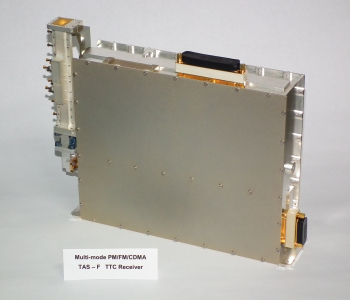-
StatusCompleted
-
Status date2019-01-03
-
Activity Code4G.00
At system level, the main objective is to allow operating frequency flexibility for spacecraft operators in case of :
- satellites co-location, for which frequency flexibility capability can ease the frequency coordination process,
- satellites re-location, for which frequency flexibility capability can avoid frequency coordination difficulties,
- jammer avoidance during LEOP phases (especially for Electric Orbit Raising), thanks to CDMA demodulation mode or frequency flexibility capability which allows to select another operating frequency far enough from the jammed one,
- unachieved frequency coordination at program kick off,
- unachieved internal satellite frequency coordination with COM bandwidth at program kick off.
The aim of this ARTES4 project was the development and qualification of the Command Receiver covering the following requirements :
- C, Ku, K, Ka-band frequency ranges,
- Single, dual or flexible frequency configuration
- FM, PM, CDMA, TC BPSK demodulation schemes.
The main challenges of the project are :
- the design and development of an optimized architecture to reduce the manufacturing and tuning steps of the CMR unit
- the design and the foundry of the demodulation ASIC using advanced digital signal processing techniques (including CDMA demodulation),
- the design and development of RF front ends with an unique Multi Chip Module package (MCM), integrating TAS existing and specifically designed MMICs
- the design and development of an unique LO Multi Chip Module package (MCM), integrating TAS existing and specifically designed MMICs,
- the design and development of generic printed circuit boards for IF, analog to digital conversion & ASIC functions, DCDC and platform Interface functions
- Lower RF thresholds for FM and PM demodulators (operating C/No down to 56dB.Hz for PM) coupled with Ka-band Doppler rate and capture range capabilities allowing to cover the supersynchronous transfer orbits by using generic TTC antennas and architectures.
- CDMA hybrid ranging implementation allowing to generate a standard ranging tone sequence to the TX unit synchronized with the Ranging epoch signals coming from the CDMA demodulator. The use of standard PM modulated transmitter for downlink is thus possible.
- Frequency flexibility of at least 750MHz whatever the operating RF frequency
- In orbit three mode operation i.e. PM/FM and CDMA (ETSI standard)
- Frequency flexibility of at least 750MHz whatever the operating RF frequency
- Interfering strength increase up to at least -40dBm @ between offset carrier ±20MHz & ±1GHz. This performance allows to consider firmly further evolution of the product into an integrated High Power Transponder
- CDMA demodulation (ETSI standard), at lowest threshold :
- acquisition and tracking for C/No down to 49dB.Hz for useful signal,
- acquisition and tracking for +17dB of J/S in presence of a single interferer whatever its modulation
- acquisition and tracking for +7dB of J/S in presence of 10 simultaneous interferers whatever their modulation
The development plan is based on 3 phases.
Design phase with validation of detailed architecture by either simulation or function breadboarding leading to manufacturing files definition
- detailed design of MMIC used on RF and LO chain Architecture
- design of RF, IF and LO MCM packages.
- detailed design of interface, IF and DCDC boards
- mechanical and interconnection architecture design
- demodulator VHDL coding + FPGA board design and validation
- manufacturing and tests of designed MMIC
- manufacturing of MCM package
- manufacturing and test of RF, IF and LO EM functions
- coupling tests FPGA board + RF
- validation of an EM electrically representative
Manufacturing and tuning phases of EQMs sub-assemblies
- prototype ASIC foundry
- manufacturing of 2014 CMR elementary parts and sub-assemblies.
- Assembly and tuning of EQM CMR
Qualification of EQMs.
- Taking into account different customers platforms needs, the full generic qualification was achieved through the manufacturing and test of two EQMs (EQM1 and EQM2).
- Input Frequency ranges qualified through manufactured EQM front ends modules validated in EM CMR

EQM1

EQM2
The project is completed.
The 2014 Command Receiver have been chosen on 7 commercial programs with 5 different platforms. First in orbit operations are planned before mid of 2019.



